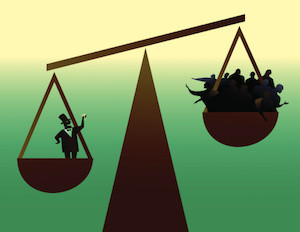Is your happiness a choice, as so many positive psychologists, coaches, classes, books, memes, and coffee mugs say? Are your feelings of joy, contentment, and purpose really under your control? Is well-being something you can improve with a few “simple steps,” as so many websites promise—including, sometimes, this one?

I’m American, and many Americans like to believe that success of any kind is largely a matter of will, despite a great deal of evidence to the contrary. In fact, according to quite a few recent studies, there are events and forces at work today that are simply making happiness much less likely for many people, and which seem to be widening “happiness gaps” between the most privileged and everyone else: the mass-death event of COVID-19 and the chaos it has caused, racism, political conflict, and economic inequality, among other problems.
And yet, people who study happiness and promote ways to get more of it keep emphasizing the same cluster of individual-level tips and tools—mindfulness, gratitude journaling, etc.—and continue to suggest that you can control much of your subjective well-being with intentional strategies. As psychologist Sonja Lyubomirsky once argued, 40% of the differences in well-being among people can be accounted for by the things individuals do, with half of the differences controlled by genetics and only 10% by circumstances.
If you move outside of happiness studies, however, to other branches of psychology as well as fields like economics and sociology, a very different picture emerges: Happiness starts to look less like an individual choice and more like a product of institutional, economic, and historical forces, shaped by power differences between groups. Though I’ve always been aware of this blind spot in happiness research, my experience during the pandemic has led me to try harder to see what’s behind that curtain—and to explore the studies that do try to understand the impact of structural forces on happiness.
Now, as the editor of Greater Good magazine, I’ve been asking myself: How should these insights affect how we talk about happiness? The answer isn’t a simple one; it begins from a place of intellectual and cultural humility, of just not knowing exactly how actions, circumstances, and genetics interact to shape our subjective well-being.
However, I have come to feel that there’s something dishonest in minimizing the role of social forces—and that this dishonestly can be rooted in discounting the experiences of people who are hurt or marginalized by those forces. We need to try to talk about happiness in a way that will, I hope, feel truer to a wider number of people—and help free us from the belief that whenever we’re unhappy we just haven’t been trying “hard enough.”
Reckoning with positivity
When I write that “structural forces” affect happiness, what do I mean? What does a structural force look like in society?
Slavery was a structural force, setting a stubborn pattern of social, cultural, economic, and interpersonal relationships between Black and white Americans that persists to this day. The family is a force structured by laws about marriage, divorce, taxes, reproductive health, children—and the power men have historically had over those laws. Your social network is a structure shaped by interactions with other structures: where you went to school, the work you do, your gender, your race, your religion—everything about you that connects you to others.
Structural forces are usually invisible to individuals, in day-to-day life; they’re something that becomes visible through study, concentration, and awareness. As is often the case with the weather, most of us generally don’t notice the laws and institutions that shape our lives until a storm of some kind blows in.
Americans’ strong resistance to seeing structural forces, especially when it comes to how they shape individual opportunity, is a tendency with deep historical roots, described in books like Daniel Horowitz’s Happier?: The History of a Cultural Movement That Aspired to Transform America. It’s also embedded in the field of psychology in this country. Whatever positive thinking’s flaws, it was a heck of a lot healthier than the alternatives, wrote the founder of American psychology, William James, in 1902: “If you can change your mind, you can change your life.”
Flash ahead almost a century to the birth of positive psychology, which was once revolutionary for the way it turned away from studying and treating dysfunction in individuals toward examining the practices and traits that helped people to flourish. In focusing on strengths, virtues, and happiness, positive psychology opened a door into human minds and relationships that science had long neglected.
That was an important contribution. Unfortunately, however, this focus on the individual led many researchers and teachers to consciously reject structural explanations for individual misfortune and unhappiness, reflecting the affluent, European-American context in which their ideas grew.
“In general when things go wrong we now have a culture which supports the belief that this was done to you by some larger force, as opposed to, you brought it on yourself by your character or your decisions,” said positive psychology’s founder, Martin Seligman, in a 1999 interview, the year after he was elected president of the American Psychological Association. “The problem about that is it’s a recipe for passivity and giving up and helplessness.”
That brand of individualism has been raked over the intellectual coals in books like Barbara Ehrenreich’s curmudgeonly Bright-Sided, Edgar Cabanas and Eva Illouz’s Manufacturing Happy Citizens, and (most recently) Jesse Singal’s The Quick Fix: Why Fad Psychology Can’t Cure Our Social Ills. However, even many individual psychologists and positive psychology organizations readily acknowledge that the field has focused “too much on the individual,” which can lead to “victim-blaming” and excuses for systemic oppression, as you’ll read on positivepsychology.com.
And yet, by and large, the field has stayed true to Seligman’s individualistic vision. I think you’d be hard-pressed to hear how social forces shape happiness in the countless lectures, seminars, classes, and books spawned by positive psychology. It was certainly not front and center at the last World Congress on Positive Psychology, the summer before the pandemic. Aside from a relative handful of papers, the field has hardly grappled with how social forces affect happiness—and that bias is reflected in books and magazines that promote positive psychology’s insights.
Who gets to be happy?
That doesn’t mean the research isn’t happening in other schools and branches of social science; especially in recent years, we’ve seen a proliferation of studies looking at the relationship between structural factors and well-being.
I’ll start with race in America. In a 2020 paper, John Iceland and Sarah Ludwig-Dehm used data from the General Social Survey (GSS) to compare the happiness levels of Black and white Americans from 1972 to 2014. They found a staggeringly large gap in the 1970s—with, for example, Blacks two and a half times more likely than whites to say they felt “not too happy.” By the 21st century, that gap had narrowed quite a bit, with almost equal numbers of Blacks and whites saying they felt “very” or “pretty” happy.
What happened in that time? Quite simply, according to the authors, Black Americans became better educated, poverty declined, life expectancies converged, and we elected more Black politicians to power, culminating with President Obama. Some things didn’t change: In fact, despite falling poverty, the Black-white economic divide is as wide as it was when the GSS started. In short, some structural factors shifted in favor of Black Americans—driven by reforms like the Voting Rights Act and affirmative action—which produced a positive change in their well-being that showed up in the GSS. It’s a result echoed by other recent studies.
The evidence for how social forces can undermine or enhance happiness goes well beyond America’s determination to marginalize and oppress racial minorities, revealing that any inequality hurts well-being.
For example, examining data from 1972 to 2008, a 2011 study found that Americans became less happy as income inequality grew—but not all Americans. Only people in the lower half of the income range felt less happy; people who made more money seemed fine as inequality rose.
When a team of anthropologists recently interviewed 170 people in Cleveland, Ohio, about what helps them to flourish and what doesn’t, they found that most participants identified work, stable income, social connection, and things like healthy food, transportation, education, and safety as being keys to their well-being. Those are almost all structural in nature; apparently, no one in Cleveland mentioned meditation. In line with other research, people earning over $100,000 a year were almost twice as likely to feel like they were flourishing than those who made $30,000 or less.
It’s a pattern you can see again and again in the research: Groups (and often countries) with less power, income, or wealth just aren’t as happy as those who have more. Perhaps the most pernicious thing about inequity is that it can rob people with less power of the ability to even know what makes them happy.
“I can think of countless examples where I felt pressured, in professional settings, in doctors’ offices, in relationships, to defer to the male perspective, to make myself small and unseen,” said my friend Kate, on the day after the Supreme Court memo on Roe v. Wade was leaked. “It has taken real work to even get to a point where I can ask myself questions like ‘Does this feel good?’ or ‘Is this making me happy?’”
In other words, Kate feels that her group needs more social power before she can better distinguish what makes her happy from what makes men happy. Not all women feel that way, of course—and their experiences matter, too. But isn’t it time we take these insights seriously when we talk about happiness? Are we really going to keep pretending that happiness is equally accessible at the same levels to everyone?
Lessons from the pandemic
Happiness inequality was already rising alongside income and wealth inequality in the years before COVID-19, as the World Happiness Report found. And during the pandemic, it appears that well-being became even more difficult for some than others.
Granted, diseases like COVID-19 aren’t structural forces to a sociologist or social psychologist, but we have created institutions and policies to mitigate the impact of disease. We felt the force of those structures when COVID-19 came to the United States, as schools, businesses, and travel shut down at the recommendation of the CDC and state-level health departments.
Such measures profoundly affected mental health all over the world, but the negative impact wasn’t uniformly felt. A new study published last month in The Lancet examined mental health across 15 countries, during the first 15 months of the pandemic. Indeed, the more stringent a country’s policies in restricting citizens’ movements and behavior, it found, the worse they felt. Note that this isn’t an argument for or against such measures; that’s not a fish I’d like to fry here. The salient point is that public policy and social forces mattered for well-being during the pandemic. As my colleague Kira Newman described, the effects of those structural forces were worse for disadvantaged groups.
I’ve written about how much my not-very-disadvantaged family suffered in January’s Omicron wave—and research suggests we were definitely not alone. According to data collected the year before by Ohio State University researchers, 66% of parents were already feeling burned out. By the time the Omicron crisis rolled over us, many parents with children in the house were at a breaking point. Seventy percent of mothers and half of fathers reported feeling overwhelmed in the first half of January of this year, according to work by sociologist Jessica Calarco.
I blamed myself for weakness, and so did most parents I know, like good little Americans. Yet Calarco suggests—and in retrospect, I can see—that our unhappiness had more to do with tending to the sick, grieving the dead, navigating chaotic school policies and patchy day care, missing friends and social events, and finding urgently-needed home tests, among many other factors. Not all those forces could be described as structural, but they were situational—meaning that the circumstances made happiness seemingly impossible for the majority of, in this case, parents with children at home. Everything was harder, and almost no help was available.
The limits of individual solutions
Despite all the evidence and all these experiences, organizations like the one I work for continue to emphasize “easy steps” and “quick fixes” that will make you as an individual happier. When the COVID-19 pandemic hit the United States, we at Greater Good knew what we had to do. Almost immediately, we began publishing research-based tips and tools for people to make the best of bad situations, with articles like “Four Ways to Feel Good on a Hard Day in Lockdown” and “How to Stop Feeling So Helpless During Quarantine.”
I’m proud to have developed, edited, and published these articles. Millions of people read them because they helped us through some very dark days; some of them helped me. I’ve never heard a persuasive argument against aiding individuals in strengthening themselves in the face of forces beyond their control. If all these articles did was to remind people to get out in the air and move their bodies during a time of profound isolation, our words were well spent.
From the beginning, we did pay attention to the structural forces affecting mental and physical health during the pandemic. In fact, Greater Good has always extensively covered research into how social forces can affect happiness; and, as a journalist, I’ve written about race, gender, and inequality for decades. None of what I’ve written here is news to me, and it’s probably not news to you, either.
What I haven’t done—what we haven’t—is allow that work to influence how we talk about happiness and how people really become happier. The point isn’t that you shouldn’t take steps research has suggested could boost your resilience and improve your relationships. Rather, it’s that we should no longer discount or underestimate the power of social forces in shaping our happiness and life satisfaction.
For example: To read magazines like Greater Good, you’d think that the keys to happiness are walking in the woods, taking meaningful photos, giving thanks, and practicing kindness—that’s all you’ll currently see on our cultivating happiness page, which I helped to write. (Note: After this essay was published, we revised and updated that page to reflect this research.)

But that might mainly be a recipe of happiness for the privileged and structurally unburdened. We don’t, at present, comprehensively acknowledge the power of racism, sexism, inequality, and other social forces over well-being. Though we’ve recently expanded content on our library of happiness practices, Greater Good in Action, to make it more culturally responsive and more inclusive of a growing number of studies of non-white and non-Western populations, the site still focuses on “simple steps to boost your well-being,” reflecting that individualistic quick-fix bias that permeates positive psychology.
It’s worth noting that the study of human happiness is evolving in response to these criticisms. “The complexity of the modern world requires intellectual flexibility and multi-disciplinary approaches,” write the authors of a 2020 paper, “Systems informed positive psychology.” Researchers need to “understand the bigger picture, including learning from history, listening to multiple perspectives with a sense of empathic wonder, and identifying potential intended and unintended consequences.”
That evolution needs to continue, in my view—and needs to go beyond the academic journals to publications like Greater Good, which speak to broader audiences. We need to stop making “happy” sound like something you can just decide to be, if you take these four or six or ten easy steps, because there are situations when nothing is easy and it’s really not your fault. We need to do more to amplify the voices of those who have been hurt or marginalized by structures and circumstances beyond their individual control, and to create a way of talking about happiness that feels more inclusive to those who have needed to struggle harder than most for whatever happiness they have. We need to look beyond tips and tools for individual improvement, toward the ways we can create a social tide that will lift as many boats as possible.
I’d like to invite our readers to do the same. You and I don’t have as much control over our well-being as we might like to, and that can be hard for people in more individualistic cultures to hear. We’re not always able to see how social forces shape our own choices and possibilities, let alone others’. But we can try, at least. And we can certainly stop talking about unhappiness as though it’s the result of ignorance or some failure of will.
Acknowledging the impact of structural forces on well-being needn’t be a “recipe for helplessness,” as Martin Seligman once argued. We’ve already seen, within the lifetimes of many people reading this, large groups of people become happier because law, culture, and the economy shifted in ways that made their happiness more likely, more often than not in response to pressure from social movements.
That inspires me, and you might consider allowing it to inspire you, as well. We need to act as if what we do makes a difference, as William James once suggested—because it does.
Thanks to Allison Briscoe-Smith, Giacomo Bono, Maryam Abdullah, Michelle Nogales, Shanna Tiayon, and—as usual—Kira Newman for their essential feedback on this essay.







Comments